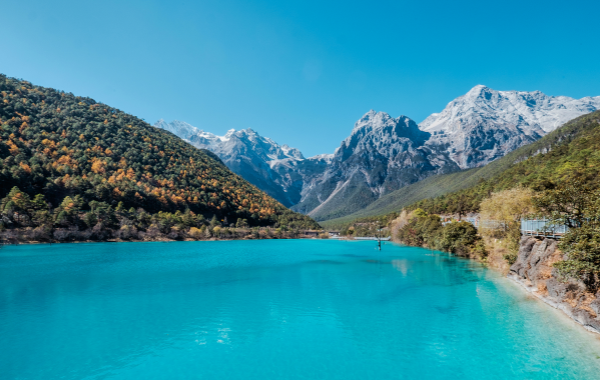Blue Moon Valley
Geographical Marvel: Where Earth Meets Sky
Located at the eastern foot of Jade Dragon Snow Mountain in Lijiang, Blue Moon Valley lies at an altitude of 2,900 meters (9,514 feet). Carved by ancient glaciers, the valley’s U-shaped terrain cradles a series of glacial lakes, each reflecting the surrounding 5,596-meter-tall Jade Dragon Snow Mountain. Its remote yet accessible location—just 30 kilometers from Lijiang Old Town—makes it a perfect escape into untouched wilderness.
The Enigma of Azure Waters: Science Meets Legend
The valley’s signature cobalt-blue lakes owe their hue to calcium carbonate and copper ions suspended in the meltwater from the glaciers above. Local folklore, however, attributes the color to a divine love story: it is said that the gods bathed in these waters, leaving behind a fragment of the moon’s glow. The lakes’ colors shift from emerald to sapphire under changing skies, creating a mesmerizing spectacle.
A Tapestry of Ecosystems: Flora, Fauna, and Alpine Serenity
The valley is a biodiversity hotspot, home to rare alpine plants like rhododendrons and edelweiss, as well as elusive wildlife such as the Yunnan snub-nosed monkey. Hiking trails wind through ancient forests, offering glimpses of cascading waterfalls and prayer flags fluttering in the breeze—a harmonious blend of nature and Tibetan Buddhist culture.

Cultural Significance: Sacred Ground for the Naxi People
For the indigenous Naxi ethnic group, Jade Dragon Snow Mountain and Blue Moon Valley hold profound spiritual significance. The Naxi view the mountain as a deity, and the valley’s lakes are believed to be its tears. Visitors often encounter stone tablets inscribed with Dongba scriptures, ancient symbols祈福 (praying for blessings), along the trails.
Photographer’s Paradise: Capturing the Eternal Moment
The valley’s ever-changing light and mirror-like lakes provide endless inspiration. Sunrise bathes the peaks in golden hues, while misty mornings create dreamlike silhouettes. Iconic spots like the "Mirror Lake" and "Silk Stream Falls" are perennial favorites for landscape photographers seeking to immortalize the valley’s ephemeral beauty.
Practical Essentials: Planning Your Visit
- Best Time to Go: Late spring (April–May) and autumn (September–October) offer clear skies and vibrant foliage.
- Getting There: Buses or private tours depart daily from Lijiang; the drive takes 45–60 minutes.
- Ticket Costs: Entry to the valley is included in the Jade Dragon Snow Mountain Scenic Area pass (approximately ¥100–150).
- Altitude Note: Acclimatize in Lijiang first to avoid altitude sickness.
Sustainable Tourism: Preserving the Paradise
As visitor numbers rise, local authorities emphasize eco-friendly practices. Trash-free zones, restricted access to fragile areas, and guided tours ensure minimal environmental impact. Visitors are encouraged to respect cultural sites and avoid disturbing wildlife.
Epilogue: Blue Moon Valley is more than a destination—it’s an invitation to witness Earth’s artistry. Whether you seek adventure, tranquility, or spiritual renewal, this celestial valley leaves an indelible impression, a reminder of nature’s boundless magic.

